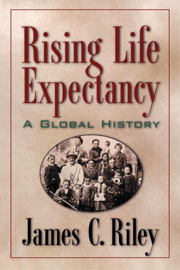Book contents
- Frontmatter
- Dedication
- Contents
- List of Figures, Maps, and Tables
- Preface and Acknowledgments
- Introduction: A Global Revolution in Life Expectancy
- 1 A Brief Overview of the Health Transition
- 2 Public Health
- 3 Medicine
- 4 Wealth, Income, and Economic Development
- 5 Famine, Malnutrition, and Diet
- 6 Households and Individuals
- 7 Literacy and Education
- Conclusion
- Index
2 - Public Health
Published online by Cambridge University Press: 05 February 2015
- Frontmatter
- Dedication
- Contents
- List of Figures, Maps, and Tables
- Preface and Acknowledgments
- Introduction: A Global Revolution in Life Expectancy
- 1 A Brief Overview of the Health Transition
- 2 Public Health
- 3 Medicine
- 4 Wealth, Income, and Economic Development
- 5 Famine, Malnutrition, and Diet
- 6 Households and Individuals
- 7 Literacy and Education
- Conclusion
- Index
Summary
Communities have long sought to cope with the toxic effects of human settlement. They buried their dead and designated and trained some people to act as healers. They also built cities, which are almost unthinkable in epidemiologic terms because cities mean more hosts for communicable diseases, easier transmission of water- and airborne diseases, and a more concentrated problem of disposing of human waste. Nevertheless, people across the globe from late prehistoric times forward found ways to make cities safe enough for their inhabitants to survive, even to increase in number. Some measures were tactics of cunning: people fled the city when dread diseases appeared there. Others were tactics of protection: the collection and disposal of human waste; the quarantine, which isolated sea vessels and the sick and well people thereon for periods long enough for the disease to exhaust itself; and the cordon sanitaire, which was meant to block the entry of disease at a land frontier. Such measures, best known for their implementation in Renaissance Italy, laid the foundations of modern public health, directing concern toward the problem of crowded urban space and to strategies of disease avoidance and prevention that allow cities to exist.
Public health acquired a more precise meaning in the eighteenth and nineteenth centuries from the contributions of European, chiefly French and British, experts. The new public health involved a conscious and overt attempt to impede disease processes.
- Type
- Chapter
- Information
- Rising Life ExpectancyA Global History, pp. 58 - 80Publisher: Cambridge University PressPrint publication year: 2001
- 1
- Cited by



